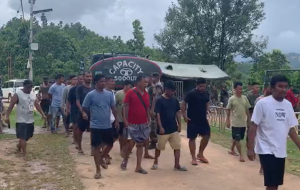The northeast Indian state of Manipur witnessed the highest displacement triggered by conflict and violence in South Asia last year, according to the 2024 Global Report on Internal Displacement by the Geneva-based Internal Displacement Monitoring Centre (IDMC). The report said that of a total displacement of 69,000 people in South Asia, Manipur alone accounted for 67,000 people.
“Figures for displacement triggered by conflict and violence in South Asia were significantly lower than the decadal average of 576,000 but still double the 2022 number, at 69,000 last year. The vast majority were the result of an increase in communal violence in India’s north-eastern state of Manipur,” the report said, adding that “Protests turned violent in Churachandpur district on 3 May, and the violence spread to other districts, including Imphal East, Imphal West, Bishnupur, Tengnupal (sic) and Kangpokipi (sic), triggering around 67,000 displacements.”
Further, the report pointed out that the displacement in Manipur was the “highest figure” caused by conflict and violence in India since 2018. It was of the view that more than three-quarters of the movements of the people uprooted from their homes took place within Manipur, but almost a fifth were to the neighboring state of Mizoram and smaller numbers to Nagaland and Assam.
Conflict in Manipur erupted on May 3 last year following a protest rally at Churachandpur by members of tribal communities. They were protesting against a judgment by the Manipur High Court directing the state government to consider granting Scheduled Tribe status to the Meitei community mostly inhabiting the Imphal valley.
So far more than 200 people have been killed in the violence, besides the thousands who were compelled to flee from their homes.
The crisis has attracted global attention with U.N. experts raising an alarm last year about reports of serious human rights violations and abuses in Manipur, including alleged acts of sexual violence and extrajudicial killings. The issue resonated in the U.K. Parliament with a member describing the violence as “premeditated and systematic.”
However, observers of the situation in Manipur, including some government officials and research institutes, are of the unflinching opinion that the displacement figures cited in the ICMD report do not reflect the reality in the state.
Kh Athouba, spokesperson of the Coordination Committee on Manipur Integrity (COCOMI), said that nearly 30,000 people of the Meitei community have been displaced. “The displacement has been mostly from Churachandpur, Moreh and Kangpokpi. They are now in several relief camps in Imphal valley,” he pointed out.
The turmoil has adversely impacted both, the Meitei and Kuki-Zo communities. The places referred to by Kh Athouba are located in the state’s hill districts where the majority belongs to the Kuki-Zo ethnic groups. Not surprisingly, members of these communities were at the receiving end of violence in the Meitei-dominated Imphal valley where thousands had to flee their homes.
Prof Kham Khan Suam Hausing, who hails from Manipur and is a faculty member at the University of Hyderabad, referred to the data released by the Kuki Students’ Organisation (KSO) that pegged the number of displaced people from the Kuki-Zo groups at 41,425. “They have been mostly rehabilitated in Lamka (Churachandpur), Kangpokpi, and Aizawl. Many have dispersed to other Indian cities like Bangalore, Delhi, Hyderabad, Kolkata, Guwahati and Shillong,” he told The Diplomat.
Other community members believe that the number of displaced people could be more than the figure arrived at by KSO. Gracy L. Haokip, who is also a member of KSO, pointed out that the data released by the student organization was genuine but based on assessment till December last year. She told The Diplomat that “in real terms, the number of people displaced from the Kuki-Zo communities is around 50,000 and these were residents primarily from the villages located in the periphery of Imphal valley.”
All these estimates of a higher figure for the displaced people in Manipur have been echoed in reports compiled by research institutes. The Rights & Risks Analysis Group in a report in July last year said: “At least 120 persons have been killed so far while around 70,000 people have been displaced, including 50,698 persons in relief camps in Manipur, over 12,000 persons who fled to Mizoram, 3,000 persons who fled to Assam, and over 1,000 people who fled to Meghalaya while thousands of the displaced have not sought shelter in relief camps.”
Violence has receded in Manipur in recent months, barring occasional incidents. But the mistrust between the two communities has not diminished, with the result that they cannot venture into each other’s zones.
A section among the displaced people, mainly from the Kuki-Zo groups, have relocated and settled in the neighboring states. But the majority, including the Meitei, continue to be lodged at relief camps in Manipur. Whether they are able to return to their homes is entirely predicated upon how fast the fault lines are blurred and normalcy is established in the state.
































